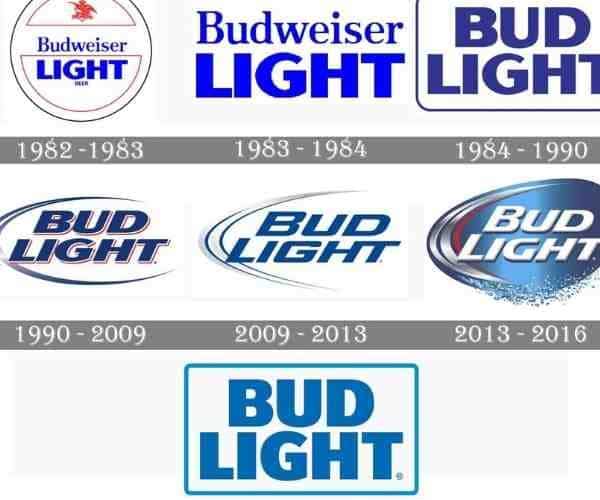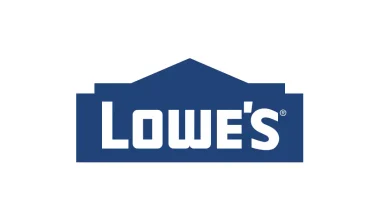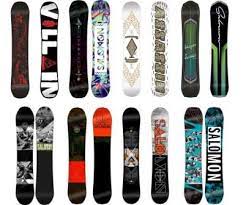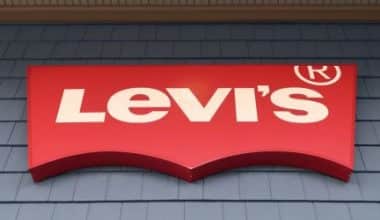The Bud Light logo features a white and blue color scheme, together with a similar font. But prior to the initial release, the Bud Light logo was different. Bud Light is one of the most widely consumed beers with the least amount of alcohol. Seltzer is one of the products under the Bud Light brand. Let’s examine the evolution of the Bud Light logo through history.
What Is Bud Light Logo?
The words “Bud Light” appear in a rectangular shape with rounded corners as part of the Bud Light logo. When it was first introduced at the beginning of the 1980s, it was simply known as Budweiser Light. Nevertheless, it has since grown to be one of the most popular products under the famous Budweiser brand.
Old Bud Light Logo
Adolphus Busch, a German immigrant, came to the country in 1857. In the year 1861, he got married. Adolphus started creating a brand that would eventually become an American icon. Then, he started working at his father-in-law’s brewery. Mr. Busch utilizes pasteurization to keep beer fresh during long-distance shipping for the first time in America.
The most popular item under the famous Budweiser brand, Bud Light, was first made available at the beginning of the 1980s under the name Budweiser Light. The announcement of the present name two years later signifies the beginning of a new era in Bud Light logo design history.
The first symbol, revealed in 1982, was a spherical insignia with an iconic red eagle perched on top and electric-blue writing in the center. The wordmark was created in two levels and two different styles, with the word “Budweiser” set in the title case and a serif typeface and the word “Light” placed in all capital letters in a bold, modern sans-serif font. The wordmark was created in two tiers and two different styles.
When Did Bud Light Change Its Logo?
In 1990, the new Bud light logo’s design and shape were selected. The italicized, double-white, and red-outlined bold sans-serif text was previously bold. The primary blue shade grew lighter and more vivacious.
Why Did Budweiser Change Its Logo?
The designer called it “more premium” and “forward-thinking.” Saint Louis Anheuser-Busch revealed a new logo, selecting an all-gold scheme that turns the iconic eagle of the beer industry to the right. The brewer, which is a subsidiary of AB InBev in Belgium, called the design “more premium” and “forward-thinking.”
“The King of Beers” is one of Budweiser’s catchphrases, and the company’s emblem, which includes a gold crown on top of the label, embodies this idea. The logo’s bow-tie style, meanwhile, evokes a sense of refinement and elegance. The company’s establishment of a corporate and brand identity was aided by the creation of the Anheuser-Busch eagle emblem in 1872, which combines the letters A and eagle.
Is the Budweiser Logo a bowtie?
In 1956, nationwide advertising for Budweiser included the bow tie for the first time. The brewery claims that too many customers were using the phrase “Bud” while ordering beer in a pub, therefore the creation of the bow tie style. The addition of the double triangles by the manufacturer is to emphasize the complete Budweiser name.
Bud Light Logo History
The history of the Bud light logo has existed since 1876. Therefore, the designers of the new trademark enhanced the vintage design.
#1. 1982 to 1983
In the early years following its initial use, the trademark’s name was Budweiser. In the US, Bud wasn’t published until much later. Thus, the 1982 sign still included the original “Budweiser Light Beer” lettering.
The initial word is enclosed in a black word with a white circle around it. The second and third are enclosed in a semicircle with the same geometric shape. The brand name used above consists of the red letter “A” and an eagle.
#2. 1983 to 1984
The logo was changed, with the words now receiving more attention. After the work was finished, only the brand name, written in two lines, remained. Budweiser, the company’s entire name, is typeset thinly above, and “Light” is typeset thickly below.
Despite the differing word lengths, this strategy maintains equilibrium between the two sections. Additionally, the creators kept the logo’s eye-catching neon blue tint. All additional information was deleted.
#3. 1984 to 1990
The moniker “Bud Light” was first used in a logo in 1984. A bold sans serif type is used to display it. A round, white rectangle with a dark blue border serves as the background.
#4. 1990 to 2009
The brand employed an updated trademark with italic typography around the turn of the millennium. The red and white shadows make the lettering appear three-dimensional. The rectangle was changed to an open oval with two curving lines in its stead.
#5. 2009 to 2013
The colors and forms have been adjusted by the designers. The name Bud Light appears to be easier to read. Now it is a light blue color without any outlines or shadows. Both the inter-letter spacing and the intra-letter gaps have grown.
#6. 2013 to 2016
The 2009 logo underwent a change in 2013 and was unveiled. The gradient gives it a 3D appearance.
Three semi-oval lines, two silvery and one red may be seen on the left. Shiny drips are drawn below to draw attention to the goods.
#7. 2016 to Today
The 1984 logo was reinstated by the company in an effort to reconnect with its past. The writing changes to blue, with a rectangular frame without rounded corners. The new logo was initially introduced to consumers in a Super Bowl commercial.
Bud Light Logo Font
Bud light logo font became popular because of the logo. The packaging for Bud Light products and the text on their websites both use the same font. Universe Next is the name of this excellent sans-serif font family for formal work.
Adrian Frutiger was its creator, and Linotype Design Studio first made it available in 2010. Now that this font has been adopted by numerous brands and businesses,
As a result, this typeface is now being used by numerous brands and businesses for their projects.
Bud Light Color
The business used Univers Next from the family of cut typefaces as their logo. Even sans-serif characters have a smooth appearance. The color scheme of the symbol has now changed to blue, which looks fantastic on a white background. Earlier than that, it was neon blue. bright blue, a violet-blue mixture of gray and red.
Color codes for the Bud Light logo
Blue Navy
- Color code #0072bd
- RGB: 0 114 189
- CMYK: 100 40 0 26
- PMS 3005 C by Pantone
Ocean Blue
- Color code #0099d4
- RGB: 0 153 212
- CMYK: 100 28 0 17
- PMS 801 C Pantone
What Is Bud Light?
Bud light is an acholic beverage. The Bud Light beer brand also produces other alcoholic beverages including seltzer. Many people enjoy that because of its all-natural flavor and components. So, it’s becoming popular all over the world. And numerous designers are anticipating a font family that they can employ in their products.
What Is on the Bud Light Label?
Bud Light adopts a large, black-and-white label that is reminiscent of those that the U.S. Food and Drug Administration mandates for packaged foods. The ingredients section of Bud Light includes water, barley, rice, and hops. Below that, in addition to more details, are the calories in a 12-ounce bottle or can (110).
Is There Yeast in Bud Light?
Bud Light comprises only five ingredients: barley malt, rice, yeast, and hops. Yeast is added at various stages of the brewing process, and it remains in the beer bottle after bottling.
Other Brands of Bud Light
A range of goods, including Bud Light, are marketed under the Bud Light brand name.
- Bud Light,
- Bud Light Seltzer,
- Bud Light Peels,
- Bud Light Chelada,
- Bud Light Platinum
- Bud Light Platinum Seltzer.
Which Bud Light has the most alcohol?
Platinum is the most expensive and has the greatest ABV, but it also has the nicest taste. Although it has the fewest calories, Bud Light still tastes like Bud Light.
Bud Light Seltzer
A new alcoholic seltzer water beverage from Bud Light was released around the middle of January 2020. The four flavors on sale are mango, black cherry, strawberry, and lemon-lime; they are all made from cane sugar and fruit flavors. 100 calories and 5% ABV are both present in each 12-ounce portion of a can.
Bud Light Seltzer is a cool drink that is hard seltzer with a faint fruit flavor. This assortment pack contains hard seltzers in the flavors of mango, black cherry, tangerine, and watermelon.
What Kind of Alcohol Content is in Bud Light Seltzer?
Because Bud Light Hard Seltzer is manufactured with alcohol derived from sugar cane, it is gluten-free.
Is Bud Light Seltzer Beer?
Bud Light Seltzer doesn’t contain any beer. This brand-new Bud Light item is a boosted seltzer drink prepared with natural tastes and devoid of malt or hops.
Is Bud Light Seltzer the Same as White Claw?
With only 100 calories and 5% ABC in each 12-oz can, these seltzers are pretty comparable. Since White Claw contains 2 grams of sugar as opposed to Bud Light’s less than 1 gram, it tastes substantially sweeter.
The Brewing Process of Bud Light Seltzer
A clear, bubbly hard seltzer is produced by combining real cane sugar, distilled water, and natural flavors. With a 5% ABV, it is also gluten-free. Due to its 12-ounce narrow can style, you’ll also note that it looks different from the traditional blue Bud Light cans.
The single-flavor 25-ounce cans and variety and single-flavor 12-packs of the slim cans will all be offered. The price of Bud Light Seltzer will be higher than that of a 12-pack of Bud Light cans, which typically ranges from $10 to $14, depending on the locale.
The most important stage in producing high-quality hard seltzer is the fermentation of actual cane sugar and distilled water, which is how Bud Light Seltzer gets its start. Bud Light regularly performs quality checks since any problems with the fermentation process might result in the development of unwanted scents and flavors. The sip goes through a five-stage filtration process after fermenting for around 20 days, then is given a fruity kick with natural flavors, and lastly, after one last quality check, is ready to go.
Because there is no beer in the seltzer, the manufacturer claims that even those who dislike Bud Light beer will enjoy it.
Alcohol Content Bud Light
Nearly all of the most well-liked beers in America fall under the 4% alcohol range. The alcohol concentration of Busch Light is 4.1%, however, Bud Light has a 4.2% alcohol content, which is notable to us because it is greater than Busch Light’s alcohol content. Amazingly, we would have thought it was the other way around.
Other Competitors of Bud Light
#1. Diageo
Diageo is the parent corporation of Guinness. The Irish brew is very popular among Americans though not comparable to domestic beer.
In 2017, the brewer exported almost 1 million barrels of Guinness to the American market, notably the Guinness Stout, which contributed to the brewery’s notoriety. Guinness’ dark draught, which it refers to as having the “perfect combination of bitter and sweet,” is what it is most famous for today.
#2. Corona Light
Corona Light is gaining enormous popularity in America, along with several other Mexican-style lagers. The rising Hispanic population in the United States not only favors recognized beers frequently, but the company is also becoming more popular among the broader public. A less caloric option is Corona Light, which has just 99 calories per can.
Due to its high alcohol concentration, Steel Reserve varies from many of the other beers on this list. The average percentage of alcohol in many of America’s favorite beers is roughly 5%. Steel Reserve is a malt liquor with an alcohol by volume of 8.1%.
#3. Golden Lager
Golden Lager is the name of the first beer that Albert Coors brewed when he established his brewery in Golden, Colorado, in 1873. After a long day of labor, the local miners would eat a hearty meal and drink their favorite locally brewed beer at banquets.
In recognition of the miners’ feasts, the Coors corporation put the name “Banquet” to the beer label after Prohibition. The beer, which is still only made in Golden, is made from Rocky Mountain water and locally cultivated Moravian barley.
#4. Dos Equis
Dos Equis is a product combining Mexican ingredients with German brewing methods. Wilhelm Hasse established a brewery in Veracruz, Mexico, in the late 19th century. Because the Roman numeral XX stands for 20, the brand was called in celebration of the coming 20th century. Dos Equis is a beer in the pilsner style.
#5. Yuengling Lager
Yuengling is one of the few significant American breweries that is still family-owned. The Pennsylvania-based brewery, which has been producing beer for almost 200 years, is also the oldest in America. It remains one of the top 20 breweries.
Despite only being available in the eastern United States, it nonetheless ranks in the top 20 beer brands in terms of barrels transported.
#6. Natural Ice
Natural Ice is a variation of Anheuser-Natural Busch’s Light, sometimes known as Natty, an ice-brewed lager made with both malted barley and corn. It has a slightly greater alcohol concentration than the brand’s Bud Ice (5.9% vs. 5.5% ABV), and critics have described it as having a bland yet clean flavor.
#7. Pabst Blue Ribbon
Pabst Blue Ribbon has developed a reputation as a hipster-friendly beer. However, pricing may have more to do with the real cause of its current sales revival. PBR sales increased during the recession because it was a less expensive option at the bar. Sales of the pilsner have remained unchanged as the economy has improved.
#8. Miller High Life.
Miller high life is a popular beer, a golden pilsner, developed in 1903 by brewer Frederick Miller. According to legend, Miller gave it that name because he thought everyone should have access to the “high life,” or good life, even those who could only afford to drink beer. He embellished the label with the phrase “The Champagne of Beers” to emphasize his claim.
When the brand first appeared, bottled beer was uncommon, therefore Miller gave his bottles high necks that resembled Champagne bottles. The beer’s bottlecaps have, at various points during its history, been covered in foil in the style of Champagne.
#9. Keystone Light.
One of the six light beers that delivered more than 3 million barrels of beer to the United States in 2017 was Keystone. But in contrast to the majority of other light beers, Keystone Light shipment volume rose. The 101-calorie light beer has sold more than 1 million barrels, outpacing all other Keystone beers in sales.
#10. Heineken
After Bud Light and Budweiser, Brand Finance has placed this 154-year-old Dutch brewery as the third most valuable beer brand in the world for the past two years. One of the most well-liked lagers in the world, despite being occasionally characterized as having a skunky fragrance.
#11. Natural Light
One of the lightest beers available is Natural Light, sometimes known as Natty Light. Natural light contains just 95 calories and 3.2 grams of carbohydrates. The lack of flavor in Natural Light is something that many drinkers would also attest to.
#12. Michelob Ultra
Over the two years from 2016 to 2017, Michelob Ultra grew more than any other significant beer on 2he American market. Shipments of light lager climbed by more than 21% from 6.4 million in 2016 to 7.7 million in 2017. Sales of Michelob Ultra have increased by more than double during the last ten years. Because it has fewer calories and carbs than other beers of a similar type, the lager is promoted as being suitable for a healthier lifestyle.
In its advertisements, it shows lean individuals bicycling, hiking, and running before cracking open bottles of Michelob Ultra.
#13. Corona Extra
The only American beer brand to ship more beer in 2017 than it did the year before was Corona Extra, one of the top five most popular beers in the country. This clear golden pilsner, which was first made in Mexico City in 1925, is the most popular beer in Mexico and the top beer exported from the nation. Modelo Especial and Corona Extra are both products of Constellation Brands.
#14. Budweiser
The self-styled “King of Beers,” which was first manufactured in 1876, is one of the best-selling beverages in the world and is sold in more than 70 nations. The procedure entails filling the lagering tanks with bits of beechwood. As part of the fermentation process, some yeast gathers on the wood, increasing its contact with the beer. By-products of fermentation are lessened, which helps the beer taste better.
#15. Coors Beer
Since Coors beer could only be found in certain western regions of the country for a long time, it developed a certain aura that other well-known beer brewers couldn’t match. The mystery surrounding Coors Light and other goods from the brewery has subsequently diminished as they were widely accessible in more areas of the nation in the 1980s before going on sale across the country in 1991. Coors Light is currently the second most consumed beer in the nation, but it is far from the most popular.
Why is Budweiser King of Beers?
In the 16th century, when Budweiser was produced in the imperial brewery of the Holy Roman Empire, Adolphus Busch made a jest about it being “King of Beer, formerly The Beer of Kings,” and as a result, the phrase “King of Beers” became popular.
What Is the Alcohol in Bud Light?
“Bud Light has a 4.2 percent alcohol content as opposed to a regular Budweiser’s 5 percent. In the United States, commercially produced beers must have a minimum alcohol content of 5%, while some may have a little higher or lower percentage.
What Kind of Beer is Bud Light?
Bud Light falls under the category of an American light lager. This is because Bud Light has 4.2% alcohol content, low bitterness (IBU of 6), high carbonation, light gold color (SRM of 2-3), uses rice in the brewing process, and bottom-fermentation instead of top-fermentation.
Is Bud Light Stronger than Budweiser?
Budweiser has a five ABV while Bud light has a 4.2 percent ABV. This implies that Bud Light is slightly lighter than Budweiser.
Is Bud Light beer or alcohol?
Bud light is a beer
What is the Weakest beer?
New data reveals that these are the 25 worst beers in the world. Molson Canada’s Keystone Ice has a 5.50% alcohol by volume. Anheuser-Busch Busch Beer, 4.30 percent
Why is Bud Light beer so good?
The greatest beer for individuals looking for simple ingredients is Bud Light. This is probably one of the main reasons it’s so popular among Americans who drink beer. The beer’s distinct and reviving malty flavor comes from the use of rice, barley malt, hops, and water in its brewing process.
Benefits of Bud light
Beers are alcoholic beverages, and while excessive intake of them may be harmful to human health, moderate consumption can still have positive effects. Here, we discuss the various advantages of beer consumption.
#1. In comparison to other alcoholic beverages, beer is healthier.
Beer has just as many antioxidants as wine, despite frequent claims to the contrary. Despite the fact that the flavonoids in grapes and barley are different from those in hops, antioxidants are still beneficial.
Protein and vitamin B levels in beer are higher than those in wine. Better yet, beer has nutrients including fiber, calcium, iron, and phosphates.
#2. Beer can shield your heart from harm.
According to studies, moderate beer consumption may reduce your risk of heart attacks, strokes, and heart disease compared to people who don’t drink.
In reality, research comparing the relative advantages of wine, beer, and spirits reveal that moderate alcohol use is can lead to a lower risk of cardiovascular disease.
#3. Beer aids in the prevention of kidney stones.
Beer consumption may lower your risk of acquiring kidney stones. A recent study shows that moderate beer drinkers, both men, and women, had a 41 percent lower chance of acquiring kidney stones.
Beers with a high hop content, such as pale ales, are full of phytochemicals that support kidney health.
#4. Beer decreases high blood pressure.
Beer’s soluble fiber can aid in lowering LDL, or “bad” cholesterol. Numerous health advantages come from increasing your consumption of soluble fiber, including the support of normal blood sugar and cholesterol levels.
Alcohol can, however, impair the body’s capacity to burn fat deposited in the body because it prevents the body from absorbing vitamins and minerals.
#5. Beer makes your bones stronger.
Beer’s high silicon content may contribute to the development of stronger bones. Orthosilicic acid (OSA), a soluble type of dietary silicon, may be crucial for the formation and development of bone and connective tissue as well as for lowering the risk of osteoporosis, a condition that thins the bones.
#6. It lessens tension.
Two beers a day, according to research, can lessen stress or anxiety at work. However, regularly using alcohol as a stress reliever might have more negative effects than positive ones. Alcohol might temporarily lessen stress, but over time, it can cause sadness and anxiety, which makes stress more difficult to handle.
#7. Drinking beer might enhance memory.
A study shows that Xanthohumol enhances cognitive performance. It is a flavonoid that aids in reducing the rate at which memory deteriorates. The substance may aid in preventing dementia-related oxidative damage to brain cells. Important information: The study’s dosage was significantly higher than what a person could reasonably take in via oral
The study’s dosage was significantly more than what a person could conceivably absorb through beer.
#8. Beer improves brain function.
An increase in alcohol consumption can lead to higher function in middle-aged participants. Although studies show that moderate alcohol can improve cognitive performance, these findings do not mean that we should promote higher alcohol consumption.
Conclusion
The Bud Light logo has undergone some changes to look current and relevant. As a result, the letters have expanded in size, and the frame is rectangular with hardly perceptible curves. Since it fits neatly on one side of the can and is simple to read, the condensed version of the name has been kept.
References
Related Articles
- Mexican Beer Brands: 13 Top Best Mexican Beer Brands You Need To Know
- CANADIAN BEER BRANDS: 20 Best, Old and Cheap Brands in 2023 (Updated)
- FOCUS GROUP: Definition and Detailed Guide on How to Run a Focus Group Discussion(
- German Beer Brands: 15+Best German Beer Brands In USA
- COORS LIGHT LOGO: Meaning, Font, Price, and History






